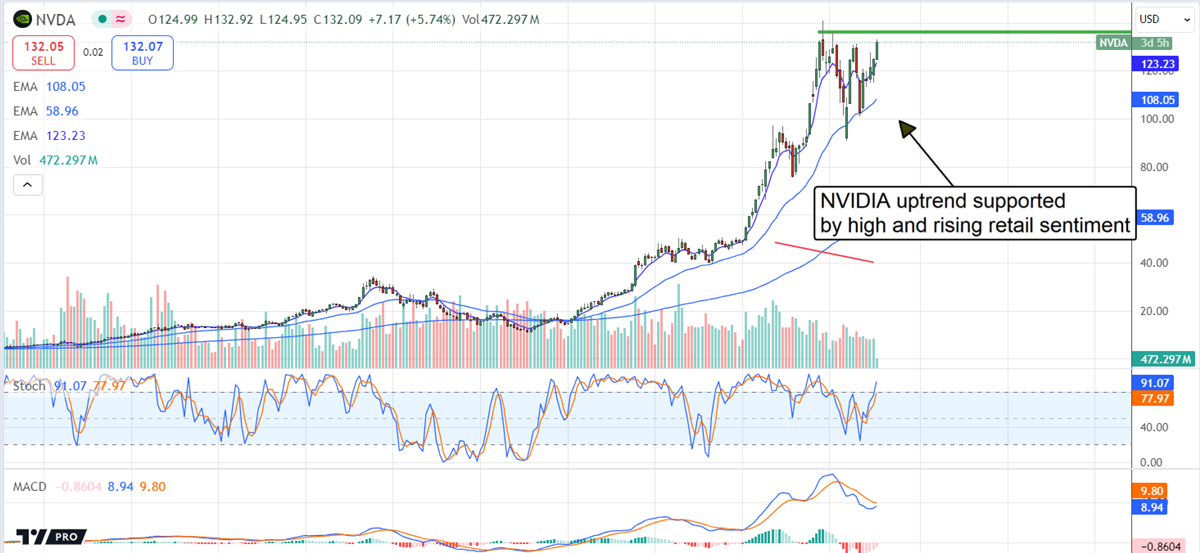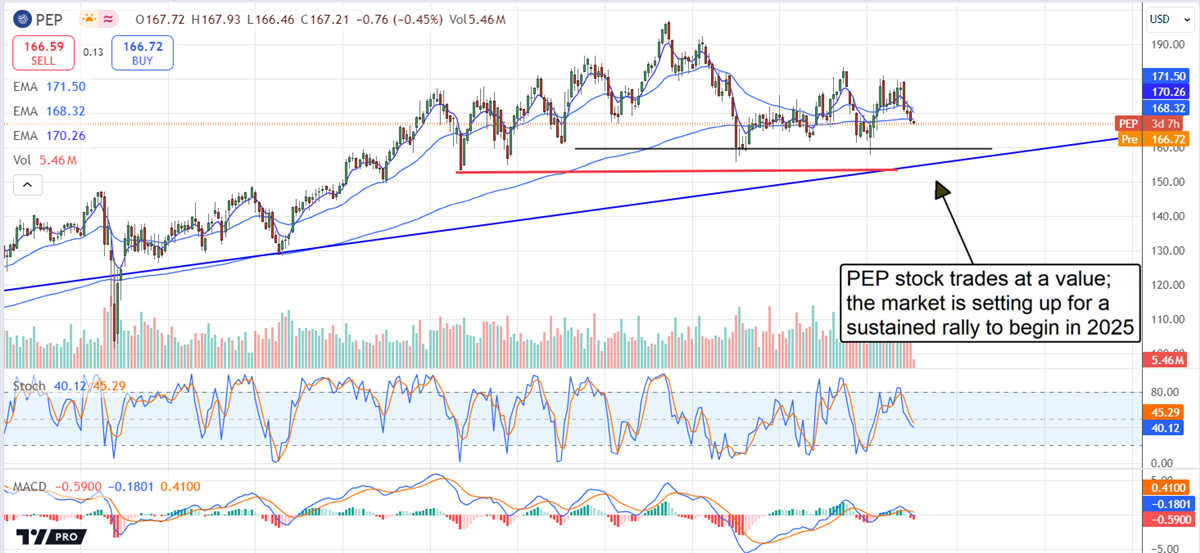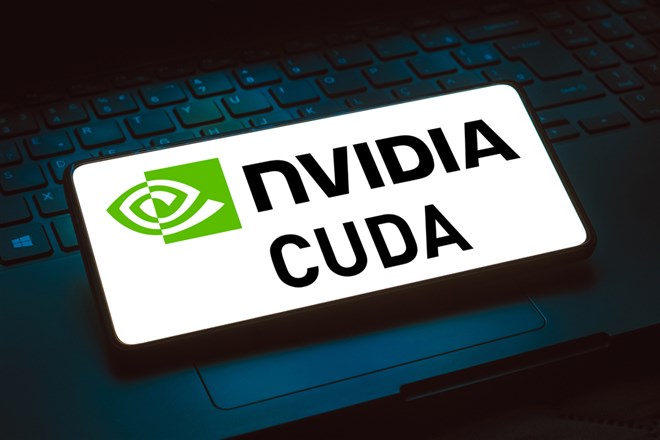Ticker Reports for October 8th
NVIDIA's AI Dominance: Why Analysts Predict Major Upside Ahead
NVIDIA (NASDAQ: NVDA) remains a favorite for retail investors for many reasons, all centering on AI.
The company’s technological advancements unleashed a sleeping beast, and its position in the industry is now unrivaled.
The critical takeaway is that NVIDIA is a favorite of more than retail investors, and the market sentiment will likely drive the stock price higher in 2025 because of results, outperformance, and guidance.
Here’s a look at some of the reasons why.
NVIDIA Has a Deep Moat
Other semiconductor labs have equally good GPUs; some perform better for specific tasks, but none have NVIDIA's full-stack offerings. NVIDIA’s success is centered on its GPUs but is primarily due to CUDA. CUDA is the acronym for Compute Unified Device Architecture and why NVIDIA GPUs are in such high demand. CUDA is an alternate operating system that allows developers to use the GPU or graphic processing device for general-purpose computing, not just graphics. Because the GPUs can run numerous computing loads in parallel, they are perfect for the high-volume computing needs of AI. Without CUDA, NVIDIA-powered AI would still be a dream.
What this means for NVIDIA is that it is no longer simply a semiconductor stock. Now, NVIDIA is critical to AI, cloud, and Internet infrastructure, providing the hardware to build the most advanced data centers, the software to operate them, and services built upon both. NVIDIA’s newest offerings are off-the-rack AI models, AI-powered generative services, and enterprise-grade software.
NVIDIA’s Is in Hyper-Growth Phase: Outperforming Expectations
NVIDIA’s growth topped 200% quarterly in late 2023 and early 2024, signaling significant market dynamics and demand shifts, permanently altering the company’s trajectory. The growth slowed in late 2024, sapping investor appetite, but that is the only negative detail. The upshot is that the company’s growth continues robustly at a near-100% pace in 2024 despite the sequential slowdown and is expected to continue at a solid, hyper-growth pace in 2025. Looking forward, analysts expect revenue to grow by another 40% to 50% in 2025 and are likely underestimating the company’s position and industry demand.
Investors should remember that the 80% growth projected for Q3 2024 is down from last year’s 205%, but the decline is due largely to the law of large numbers, and 80% is still a very, very solid figure. Looking at the data in dollar value terms, 80% growth in Q3 2024 is worth $16.5B compared to roughly $12.25 billion in growth in 2023. That’s 135% of the 2023 Q3 dollar value growth, and outperformance is also expected in 2024.
NVIDIA has outperformed the consensus estimates 100% of the time since Q3 2022 and only missed consensus once since before 2020. Outperformance since 2023 has been compounded by increased guidance, often running 500 basis points or more above the consensus forecasts, which is also expected to continue. Recent commentary from Super Micro Computers, which wowed investors with projections for shipments of its latest GPU products, aligns with that outlook.
Stock Splits, Dow Inclusion, and Dividends
NVIDIA’s stock split fueled investor appetite for more reasons than one. At face value, the split made shares more accessible to smaller investors and suggested that upward momentum in the share price would continue. Stocks that split shares tend to outperform the S&P 500 by 2:1 and NVIDIA’s business is clearly outperforming the average S&P 500 company, so higher share prices are expected.
Coincidentally, another stock split is likely, given the share price outlook. The split also raised hopes that NVIDIA would be included in the Dow Jones Industrial Index, which would increase buying because of demand from indexed ETFs, mutual funds, and other Dow followers.
Another catalyst eyed by retail investors is the dividend. NVIDIA’s dividend isn’t robust but reliable, and growth is expected. The surge in earnings power resulted in significant cash buildup, with positive cash flow expected to remain robust, raising the chances for significant distribution increases. As it is, the $0.01 per share distribution is worth about 0.03% in yield and only 1% of the earnings outlook. Share repurchases also compound the dividend. Repurchases in FQ2 reduced the quarterly count by 0.6% on average and are expected to continue at the current pace or higher.
Analysts Lead NVIDIA to a New All-Time High
The analysts' support is another reason retail investors like NVIDIA. The analysts are overwhelmingly bullish, with 43 rating the stock as a consensus Buy and 90% rating it as Buy or Better. The price target, which assumes more than 10% upside from the critical resistance target, is also trending higher, leading to the high-end range near $175 or about 40% upside from the critical level. The critical level is near $135 and could be broken before the FQ3 results are released in November. If so, the technical targets the move would produce align with the high end of the analyst range.

INVESTOR ALERT: AI Stock on the Verge of Blasting Off
AI was by far the biggest tech investing trend right now.
But Ross Givens says the #1 artificial intelligence stock[/lin] is NOT Microsoft, Google, Amazon or Apple.
Nope — his research is pointing to a tiny, under-the-radar stock that's trading for just a few dollars right now…
And could soon shoot to the moon, handing early investors a windfall.
These Stocks Are Using Buybacks to Unlock Big Gains for Investors
Over each quarterly announcement coming from companies, investors tend to focus a lot on the net earnings per share (EPS) figure and not a lot on metrics that matter – arguably – just as much. Today, investors have an additional insight into a select few companies that show aggressive new share buyback programs approved by management teams in recent months.
There are two ways that investors typically get a return from investing in stocks: one is capital gains from buying low and selling high, and the other is the dividend income side of the business. But, there’s a third way to generate upside in a stock investment that is more attractive for investors and tax efficient. This third way is through stock buyback programs.
But, before investors determine the benefits of buybacks, a list of these aggressive programs should be kept in mind. Starting with the energy sector, management teams at Marathon Petroleum Co. (NYSE: MPC) are taking advantage of low oil prices while they last. Then there’s Bank of America Co. (NYSE: BAC) to squeeze the upside in bond holdings from the financial sector. Finally, consumer staples and their attractiveness are seen in Altria Group Inc. (NYSE: MO).
Why Stock Buybacks Are Better Than Dividends for Investors
Let's say there are 10 shares of a company, and an investor owns one. That person has a 10% ownership in the business. Now, management has bought back two shares of the business, and only eight shares are outstanding. That same investor (holding one share) has increased to an ownership rate of 12.5% from the previous 10% without doing any work.
That higher ownership rate is more valuable on a per-share basis (since supply contracted), and that’s how some companies manage to compound the value of their companies without much effort. More than that, there’s a better tax treatment.
Dividends are taxable income for investors, and they are paid with capital already taxed in the business. Stock buybacks don’t carry this double-taxation characteristic that dividends do, further boosting the upside effects and a clear advantage over dividend income.
Marathon Petroleum's Clear Path to Upside
Now that the Federal Reserve (the Fed) has cut interest rates by the most aggressive rate since the financial crisis of 2008, the business cycle is facing a new potential spark higher, which almost always carries higher oil demand. Knowing this, Warren Buffett bought up to 29% of Occidental Petroleum Co. (NYSE: OXY) before oil broke out.
Buffett is not alone in his bullish view of oil stocks, as Marathon’s management decided to approve a stock buyback program of up to $5 billion this quarter, representing roughly 8.8% of the company’s market capitalization for an aggressive buyback.
Buybacks also mean insiders think the stock is relatively cheap enough to buy at current levels. Wall Street analysts would agree with this fact. The consensus price target for Marathon Petroleum stock today is set at $196.1 a share, which calls for up to 13.2% upside from today’s stock price.
Higher Bond Prices Could Propel Bank of America Stock to New Heights
Management knows that, which is why they approved up to $25 billion in capital to be used for stock buybacks, which also represents approximately 8% of the bank’s market capitalization today. Here’s why that decision might have been made.
As interest rates come down, bond prices increase, and Bank of America’s financials show the bank is holding up to $368.1 billion in treasury bonds. Knowing that these bonds could significantly go up in value, therefore boosting the bank’s valuation, analysts at Oppenheimer decided to boost the stock’s price target up to $49 a share for a 22.8% upside from today’s price. Management seems to be on the same page when it comes to the potential run this stock can have in the coming months.
New Price Target Boosts for Altria Stock
Apart from management at Altria approving a stock buyback program of up to $1 billion, others on Wall Street also decided to make their bullish view for the company public. Analysts at Bank of America have now landed on a $57 a share price target for Altria Group stock, calling for as much as 14.2% upside from where it trades today.
More than that, institutional buyers like Legal & General Group boosted their net holdings in Altria stock by 1.6% as of August 2024. This may not seem like much on a percentage basis. Still, it now nets their investment at up to $562.8 million for nearly 1% ownership in the company.
The picture wouldn’t be complete without investors knowing how Altria stock is valued compared to the rest of the staples sector. Trading at a P/E ratio of 10.5x today, the stock is at a 50% discount to the staples sector’s average valuation of 20.5x today. This is what management saw as justification for the buybacks and what investors should consider as well.
AI Detects Profit Surge On Monday
This has given investors the opportunity to beat the market by 1,700% and a 100% win rate to begin the year.
See here to see the full details.This Is the Entry Into PepsiCo You've Been Waiting For
Investors looking to enter PepsiCo (NASDAQ: PEP) stock or build on existing positions should rejoice. The FQ3 2024 earnings report was weaker than expected, causing the stock price to dip. While weaker-than-expected results and a soft outlook for revenue aren’t news to be happy about, the tally isn’t as bad as headlines make it seem, and there is the long-term outlook to consider.
PepsiCo is the world’s largest consumer staples company, impacted by internal and external one-offs that will soon pass. Until then, it is a solid, reliable dividend payer of Dividend King quality and will weather the current downturn in activity as it has done in the past, which is very well.
The critical details for investors to focus on today are the valuation and dividend yield. The stock, down from highs set in 2023, trades at roughly 20.5x its earnings outlook at the low end of the historical range. Likewise, the dividend distribution, which is expected to continue growing, yields about 3.25%, with shares near critical support levels and at the high end of the historical range. Investors that buy in at the current levels have limited risk and potential for a 50% share price increase at the high-end valuation range. There can be no better time to enter a blue chip stock such as this regarding long-term investing, portfolio maximization, total returns, and dollar-cost averaging.
PepsiCo’s Soft Q3 Is No Concern for Long-Term Investors
PepsiCo had a softer-than-expected Q3, but each negative was offset by a positive, leaving shareholder value improved and the long-term outlook unchanged. The $23.32 billion in net revenue is down -0.6% compared to last year and missed the consensus by 200 bps, but organic growth is present, and the margin is good. Organically, core operations are up 1.3%.
Segmentally, Quaker North America was the weakest, with a contraction of 13%. However, the weakness is primarily due to the recalls in Q1 and the subsequent shuttering of a plant believed to be the source of contamination. Weakness was also seen in Frito Lay North America, but the 1% contraction is less of a concern and offset by organic growth in PepsiCo North America, Latin America, and Europe. Asia-Pacific (APAC) is the weakest regionally, with a contraction of -1%, impacted by rising geopolitical tensions.
PepsiCo experienced margin contraction in Q3, but aggressive cost controls and increased efficiencies produced a better-than-expected result. The takeaway is that adjusted earnings grew compared to last year and outpaced the consensus target and organic revenue growth. Because cost controls and investment in operational efficiencies are part of the equation, investors can expect a leverage rebound in earnings when top-line growth resumes, likely to be sometime in F2025.
Guidance is also mixed, with the revenue target reduced but organic EPS growth targets reaffirmed. The salient detail is that operational improvements are expected to stick, providing sufficient cash flow to sustain the fortress balance sheet while returning capital to investors and investing in the business. Regarding the balance sheet, the company produced positive cash flow operationally but negative cash flow for the business. However, that detail is offset by the timing of debt issuance and repayment, increased assets, decreased liability, and a 5% improvement in shareholder equity.
PepsiCo Capital Returns Help Support the Price Action over Time
PepsiCo’s capital return is reliably safe and growing. The company’s dividend distribution is up 7% per share compared to 2023, aided by repurchases. The repurchase activity is up incrementally compared to last year, and the count was reduced by 0.35% for the quarter and YTD periods. Investors may expect to see distribution increases slow in 2025 but not cease; share repurchases are also likely to continue at the current pace.
The price action in PepsiCo stock was tepid following the release, leaving the stock price down in early trading. However, the market is trading near a floor at $160, where support has been strong and is likely to produce a rebound. The $160 floor coincides with a significant uptrend line in 2024, so the rebound could be strong and result in a sustained uptrend in 2024.
Among the catalysts for 2025 are a return to top-line growth, leveraged results on the bottom line, and the possibility that growth will exceed the current forecasts because of the addition of Siete Foods. Siete Foods is a Mexican-American food brand growing above the industry’s 4% CAGR, providing inroads into a new product vertical worth billions in annual revenue while complementing PepsiCo’s better-for-you food offerings.






